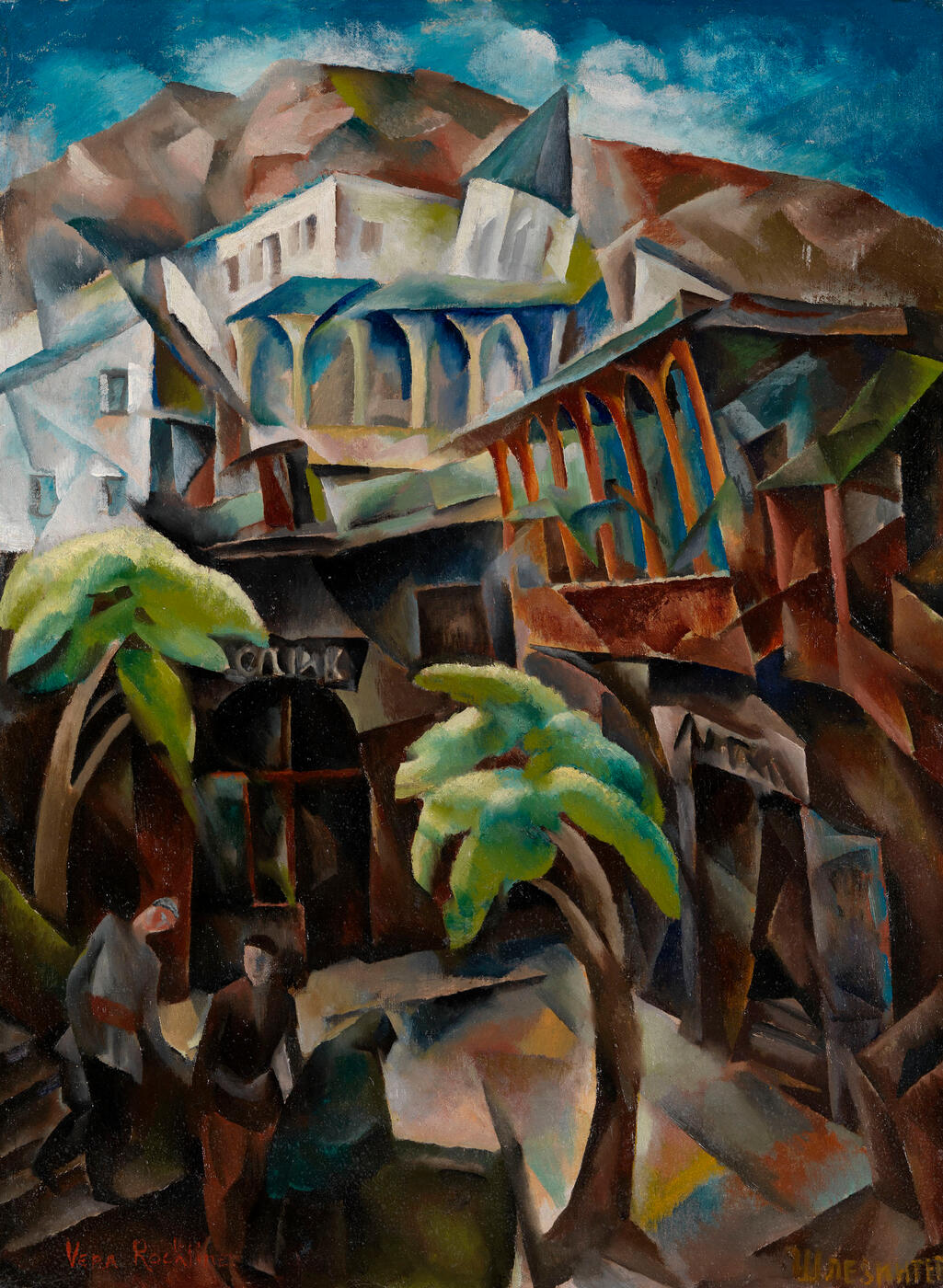5 June 2013 Russian Art Auctions
5 June 2013

74. ROCKLINE, VERA (1896-1934)
Environs de Tiflis, signed twice, once in Cyrillic "Schlezinger", also further signed in Cyrillic and numbered "N1 Schlezinger" on the reverse.
Oil on canvas, 89 by 65.5 cm.
350,000–400,000 GBP
Executed c. 1919.
Provenance: Galerie Jean Battais, Paris, until 1975.
Acquired from the above by the previous owner.
Private collection, France.
Acquired from the above by the present owner.
Private collection, Europe.
Exhibited: Vera Rockline, Galerie Jean Battais, Paris, 1974, No. 9 (label on the stretcher).
Retrospective Vera Rockline. 1896–1934, Galerie Jean Battais, Paris, 22 May–12 June 1975, No.
4 (label and stamp on the stretcher).
Literature: Exhibition catalogue, Vera Rockline, Paris, Galerie Jean Battais, 1974, No. 9.
Exhibition catalogue, Retrospective Vera Rockline. 1896–1934, Paris, Galerie Jean Battais, 1975, No. 4, listed and reproduced on the cover.
Environs de Tiflis is one of very few known works of Vera Rockline’s Russian period. The artist developed a passion for painting Cubist townscapes in the late 1910s under the influence of Alexandra Exter, her tutor in Kiev, whose studio the young artist, still bearing her maiden name Schlezinger, joined in 1918 after moving there from Moscow. Before this, she had been studying at Ilya Mashkov’s Moscow studio where, according to her contemporaries, she painted Neo-Impressionist work, of which little is now known.
In the years 1918–1919, still under the name of Schlezinger, the artist took part in the Moscow Fellowship of Artists’ 24th exhibition; the 2nd exhibition of pictures by the Artists’ Union in Moscow; the exhibition of Jewish artists’ painting and sculpture; and the 5th National Exhibition of painting From Impressionism to Non-Objectivity. The same year she married and left for Georgia with her new husband and in 1919–1920 she created a small series of paintings and drawings of the country’s capital.
In Environs de Tiflis, executed c. 1919, Rockline lent a powerful and contemporary vibrancy to her depiction of the ancient Georgian city by combining dazzlingly brilliant colour with a Cubist handling of form. The panorama of Tiflis, stretching from the square to Mount Mtatsminda and St David’s church looming over the city, is coiled up like a spring and united into a single scene, with space compressed into a concentrated fragment of the field of view. The symphony of street signs, with cut-off signboards as a major theme, the tree in the foreground and the faceted dome of one of Georgia’s greatest shrines, already featured in previous views of Tiflis by Rockline, are not so much recurring motifs as testimony to their final formulation as sculptural forms.
Unlike most landscapes in this cycle, Environs de Tiflis is not deserted, but peopled with inhabitants. Three human figures descending the steps on the right bear witness to the life going on around. The main emphasis, however, is on the sculptural expressiveness of overlapping volumes. Houses are vigorously carved up into shining facets, allowing them to be seen from multiple viewpoints simultaneously. Rockline makes maximum use of opportunities to flatten out space, as ever restricting the perspective depth of her Cubist structures by a succession of walls or the crested ridge of a mountain. Environs de Tiflis not a view of the city: it is the city’s shapes – dismembered, broken down into their constituent parts and assembled in a new way.
In the years that followed, Rockline continued to develop different approaches to form while preserving a palette of intense colours. But the Caucasian capital’s dynamic and brilliant image became one of the fascinations of Russian avant-garde painting, which proclaimed the Orient as the basis of modern art. This image found its
most expressive and vibrant embodiment in this view of Tiflis.
Notes on symbols:
* Indicates 5% Import Duty Charge applies.
Ω Indicates 20% Import Duty Charge applies.
§ Indicates Artist's Resale Right applies.
† Indicates Standard VAT scheme applies, and the rate of 20% VAT will be charged on both hammer price and premium.